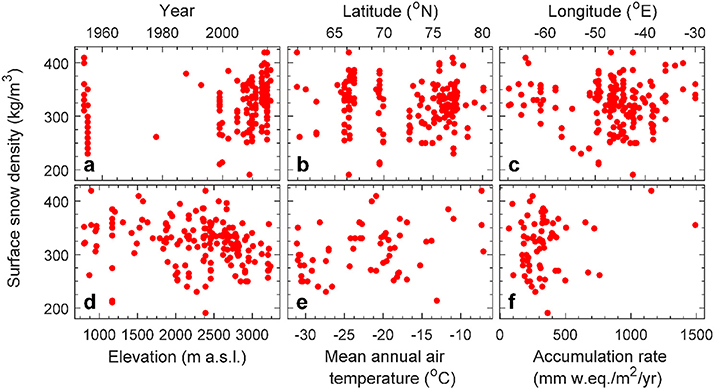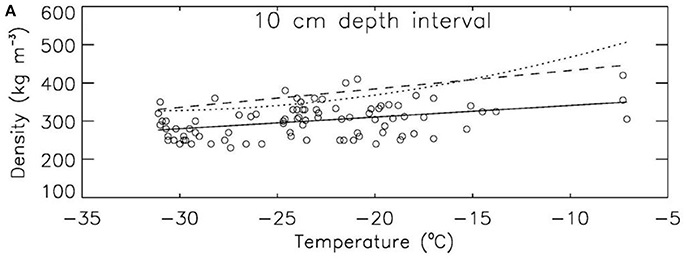We have a new open-access study in the current volume of Frontiers in Earth Science that tries to estimate snow density across the Greenland Ice Sheet1. Snow density might seem like an unexciting topic, but it is fundamental to blending ice-sheet thinning or thickening observations with surface mass balance simulations to assess ice-sheet health. Clearly, assuming a snow density of 400 kg/m3 makes a snowfall event observed by satellite altimeter twice as massive as assuming a snow density of 200 kg/m3 (and vice versa). There are several mathematical formulations presently being used to estimate snow density. These existing approaches generally estimate snow density as a function of more accessible geographic or climatic parameters.

Figure 1 – Locations of the surface snow density measurements collected in this public dataset. Contours lines indicate elevations in meters above sea level.
In this study, we assembled a large database of snow density measurements from the Greenland Ice Sheet. These measurements were collected from a variety of scientific expeditions going back to 1954, and provide the most complete spatial coverage of the ice sheet that is presently possible. Despite running a lot of statistics on this database, we could not find a compelling proxy for snow density. Our analysis indicates that snow density cannot be reliably predicted by common geographic (i.e. elevation, latitude or longitude) or climatic (i.e. air temperature or accumulation rate) variables. As existing approaches to estimate snow density rely on these common geographic and climatic variables, this was a somewhat unexpected finding.

Figure 2 – Snow density (0 to 10 cm depth) plotted against: (a) measurement year, (b) site latitude, (c) site longitude, (d) site elevation, (e) mean annual air temperature, and (f) accumulation rate.
Our study therefore recommends that the average measured density of 315 ± 44 kg/m3 (± standard deviation) is the most statistically defensible assumption for snow density. This recommendation of a constant, or zero-order approximation, differs from previous studies that have recommended estimating snow density as a second-order polynomial function of near-surface ice-sheet temperature. We show that these previous approaches may systematically overestimate snow density by 17 to 19 %. This is partially due to their mathematical formulations, but mainly due to previously considering measurement depths of up to 1 m as characteristic of “snow density”. As density increases with depth in the relatively porous near-surface layers of the ice sheet, we are instead careful to only include density measurements to a depth of 10 cm.

Figure 3 – Snow density (0-10 cm depth) versus mean annual air temperature. Solid line indicates the regression of this study, while the dotted and dashed lines indicate previously published temperature-dependent formulations for estimating snow density.
We hope that the approach of estimating snow density that we are proposing, which is mathematically less complex but statistically more robust, will be useful to researchers working with both surface mass balance simulations and satellite altimetry observations, as well as researchers modelling process-level studies of snow compaction and meltwater percolation in the near-surface ice-sheet layers. This study was supported by the Danish Research Council and the Programme for Monitoring of the Greenland Ice Sheet. Our database of 254 snow density measurements is freely available in the supplementary material of the study.
Here’s a plain-written intro to our paper on Greenland Ice Sheet snow density: https://t.co/eKmcnALonB
The unexpected upshot? Snow density does not actually appear to vary w/ geographic or climatic variables! ❄️ pic.twitter.com/ILwFkTZRdS— William Colgan (@GlacierBytes) May 7, 2018
